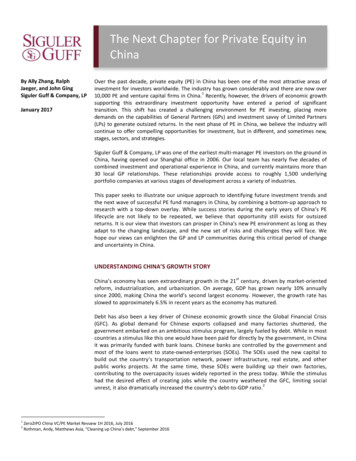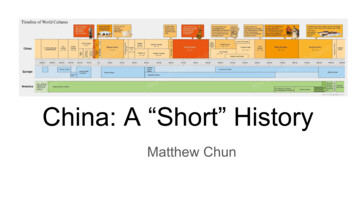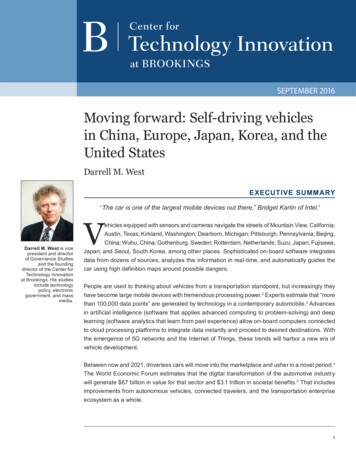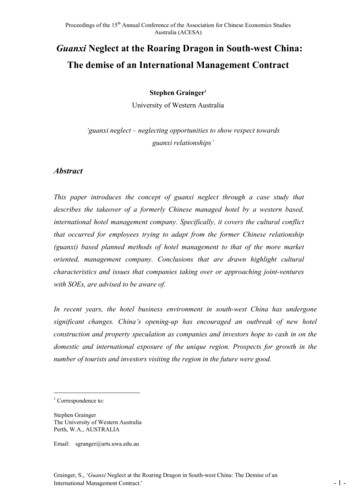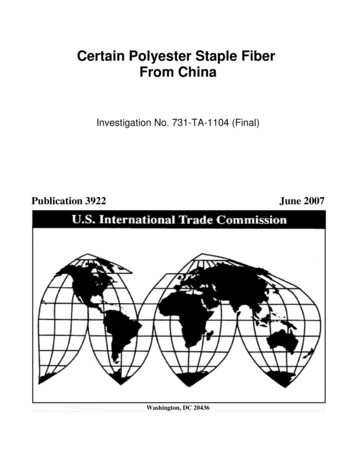
Transcription
China's Film Industry– a New Era
ContentsIntroduction1Trend One: From Bigger to Biggest2Trend Two: From "Made in China" to "Made for the World"3Trend Three: From "non-intelligent" to "Intelligent"5Trend Four: From "Highly Concentrated" to "Diversified"7Trend Five: From "Long Tail" to "Thick Tail"10Trend Six: From "single IP" to "IP franchises"12Trend Seven: From "non-Conforming" to "Standardization"13
China's Film Industry – a New Era IntroductionIntroductionChina's culture and entertainmentindustry has entered into anunprecedented "golden age". Withbox office revenue of RMB44 billionin 2015, China is the fastest growingfilm market in the world. By 2020,China's box office is expected to reachRMB200 billion and will exceed NorthAmerica as the world's largest marketin box office revenue and audiencenumbers.Driven by policy, Internet, andcapital, "new giants" are emerging.In particular, Internet companies, ledby BAT, and real estate developerssuch as Wanda, have used resourceadvantages to gradually penetratethe entertainment industry andbuild an ecosystem. For instance,Wanda Group, a Chinese propertydeveloper, has merged its culture andproperty resources, taking advantageof its commercial property to buildmovie theatres, and expanded intothe upstream film industry withits channel advantage. Since itsacquisition of AMC EntertainmentHoldings Inc. (AMC), Wanda Grouphas become the largest cinemachain operator in the world. In early2015, Wanda Cinema was listed onthe SME Board of the ShenzhenStock Exchange, and became thefirst cinema chain stock to list on thedomestic stock market.These "new giants", backed by vastuser base and channel advantages,are eroding the influence of"traditional giants". Faced witha rapidly evolving situation bothinside and outside of the industry,"traditional giants" have sensed theurgency for change. To "traditionalgiants" in the culture industry,Internet Plus-based transformationand comprehensive industry chainrestructure have become commontrends. For example, with Disney as itsmodel, Huayi Brothers has launched a"de-cinematic" strategy that integratesthe traditional film business, Internetentertainment, and location-basedentertainment, and expands intoupstream and downstream industrychains to alleviate dependence on thefilm industry.In the next five years, China's cultureand entertainment industry is on trackfor speedy development. Mainstreamforms of entertainment such as film,online videos, and TV will experienceprosperous development; competitionbetween "new giants" and "old giants"will become fiercer; cross-industrycooperation and competition willcontinuously come into play, theindustry chain will be shuffled andtransformed, and opportunitiesand challenges will co-exist. Theculture and entertainment industryis ushering in a new era, and the filmindustry should witness the followingseven key trends.1
China's Film Industry – a New Era Irend One: From Bigger to BiggestTrend One: From Bigger to Biggest1.1 China's box office revenueand number of movie-goers areexpected to surpass North Americaby 2020The size of China's film industryis made up of three parts: filmconsumption, film and theaterinvestment, and film export. On thefilm consumption front, China's filmindustry maintained rapid growth, withcombined revenue of RMB66 billion1in 2014. In recent years, revenuegenerated from non-box office, filmcopyright, and advertising (theaters,TV, and Internet) has grown rapidly,providing important support for thecontinuous expansion of China's filmconsumption. Regarding film andtheater investment, investment innew theaters is expected to stabilize,and the extensive operation modelwill be replaced with an intensive one.Moreover, against the backdrop oftheaters overflow and high costs infirst-tier cities, steady expansion intosecond, third, and fourth-tier cities willbe rewarded with better returns. ForFigure: China's film industry market size forecast (2014-2020)2RMB200 plus billionby 2020RMB66 billion in 201427%Film IP(3%, 0.3)Film consumptionAdvertising(9%, 1)36%139%Renovation/expansion(6%, 0.68)New theater investment(17%, 1.92)Theater andmovieinvestment(8.6%, 0.95)Film export (2.7%, 0.3)1 ENT Group2 ENT Group, Deloitte Projection2Non-theaterinvestment(2%, 0.19)Film investmentFilm exportfilm export, due to cultural differencesbetween China and foreign countries,legal considerations, and other factors,only mild growth is expected, with littleimpact on the industry as a whole.According to Deloitte's forecast, by2020, China's film industry will seefurther expansion, with revenuereaching RMB200 billion. By then,China will overtake North Americain box office revenue and numberof movie-goers, and will become thelargest film market in the world.
China's Film Industry – a New Era Trend Two: From "Made in China" to "Made for the World"Trend Two: From "Made in China" to "Made forthe World"2.1 Co-productions should enjoyfavorable status, resulting "winwin" for China and its foreigncounterpartsIn the past, the scale of China'sinvestment in the foreign film marketand China's film exports wereunsatisfactory. However, in recentyears, as China has become the world'ssecond largest box office market, aninflux of foreign investors and filmproducers have shown willingness tocooperate with China. Co-productionsare a way for China's films enterglobal and for foreign films to gainaccess to China. At present, half ofcountries listed as top 10 internationalbox office markets have signed coproduction agreements with China,and the number of co-productionshas increased to some extent. Thoughco-productions only accounted for asmall proportion of the total numberof productions in the Chinese filmmarket, they contributed a significantpercentage of total box office revenue.In 2014, co-productions accountedfor 6 percent of total productionsscreened in China, but contributedaround 50 percent of total box officerevenue. In the first quarter of 2015,co-productions contributed 60percent of total box office revenue.Co-productions can achieve "win-win"outcomes because co-produced filmsis considered as "Made in China" andenjoy the same treatment as domesticones. Compared to imported films, coproductions enjoy better distribution,revenue sharing percentage, andpolicies. Nonetheless, co-productionsare still faced with many challengessuch as copyright ownership, culturaldifferences, and different work styles.Figure: Box office contributions by nations/regions (2015 Q1, Top five)3HK42.6%U.S.37.8%France10.8%South Korea54% contribution5.7%U.K.3.0%0%10%20%30%40%50%3
China's Film Industry – a New Era Trend Two: From "Made in China" to "Made for the World"2.2 Co-productions for the globalmarketCurrently, most co-productions aretargeted at the Chinese market. WolfTotem, released in early 2015, wasa China-France co-production. Themovie used many Chinese elements, itsmain scenes were shot in China, andalmost all of its actors were Chinese.Western resources were mainly usedfor content creation, such as direction,and Chinese-foreign diversified capitalsupport. This film had great success inthe Chinese market, earning RMB700million at the box office in 35 days.Figure: Co-productions for global market4Co-productions forglobal marketChinese productions forChinese marketHowever, achieving success in theChinese market is not the ultimate goal.For instance, Fast and Furious 7 , screenedin 2015, was not only targeted at theChinese market but also the globalmarket. It leveraged the best resourcesin the world, received investment fromglobal investment platforms and madeRMB2 billion in its first 15 days. Like thismovie, achieving success in the global3 ENT Group4 Deloitte Analysis4market is the ultimate goal for Chinesefilms. With co-productions becomingmore mature and cooperation growingdeepener, there will be an expandedco-production market, thus fuelingthe co-production trend and achievingsuccess for Chinese film in the globalmarket.
China's Film Industry – a New Era Trend Three: From "non-intelligent" to "Intelligent"Trend Three: From "non-intelligent" to "Intelligent"3.1 Big data will be used to drivedecision optimization and profitgrowthAt present, the utilization of Internetand big data has impacted the wholefilm industry chain including IP,production, marketing and promotion,distribution, and ticket sales. Amongthese, Internet giants investedcontinuously in the film industry,and Internet film companies such asTencent Pictures, iQiYi Films, and BaiduPictures, are all entering the moviebusiness. Traditional film companiesare also actively responding to thissituation. For example, ShanghaiNew Culture Media (listed on theA-share market) along with others allannounced private placement andinvestment plans on Internet and bigdata technologies, with a total amountof over several billion yuan.Figure: Impact of Internet and big data technologies on the value chain of the film industry5ProductionTurns tocustomer-focused Crowd funding: consumers invest andinfluence production. Internet IP: emergence of Internet IP. Social network: fans actively participatein decision-making process.DistributionData-driven Innovation: Using online ticket sales,analyze customer distribution andfilm popularity to improve distributionefficiency and resource use efficiency. Big data: precise estimation of boxoffice revenue.Marketing Newmedia-driven"New media"B Video: play trailer, launchpromotiondu Online: precise marketing,improve sense ofparticipation"Internet Plus" Big dataSocial networksCrowd fundingInternet IPVideoOnline activitiesBAT investmentTheaterOnlineData-driven More power:consumers enjoygreater voice. Derivative products:diversified online offline activities.UserHigher status Online seat reservation: online ticketsales surpass offline ones; makeshooting decisions based on ticketsales data; increase attendance. New channels: theater is no longer theonly channel, paid video mode is onthe rise.5 Deloitte China Analysis5
China's Film Industry – a New Era Trend Three: From "non-intelligent" to "Intelligent"Production and distribution:With the exception of some highquality scripts, film making andproduction will be more driven bymarket demand. The right to selectcontent and main creative personnelwill gradually transition from producersand directors to movie-goers. Morefilm IP will be based on Internetcreations. Films will be invested andproduced based on data on moviegoer's preferences regarding content,actors, etc. from Internet and socialnetwork, thereby achieving moreprecise market positioning and boxoffice forecasts, and higher investmentreturns.Marketing:Data on new media users makes itpossible for precise marketing of films.Traditional marketing methods such asposters and trailers are not sufficientfor large scale film marketing andpromotion. New media technologiesare being used for film marketing,which will match film content tothe target audience, and audiencefeedback on preferences will be usedfor adjustment of marketing strategies,which should increase box officeearnings.Online ticketing:Another change to the film industrybrought by Internet is that online6 ENT Group6ticketing has upended traditionalticketing channels. Online ticketingplatforms have great influence andrelated marketing is essential to drivefilm consumption and penetratethe upstream film industry to helpintegrate the film industry andInternet. The online ticketing sectorhas attracted many competitors suchas Meituan, Gewara, Wepiao, Taobaomovie, and Dianping, among others.Online ticket sales accounted for 63percent of total ticket sales in Q12015.6 In addition, online ticketingplatforms have streamlined the filmwatching experience.Cinema screenings:In the link of cinema screenings, thereis big potential for data analysis, whichwill be used for decision and serviceoptimization. Breakup Buddies, priorto its official screening in 2014, usedthe online booking platform Meituanto lock up over RMB100 million in boxoffice through online booking. Onthe basis of the film's online sales, itsscreening rate in domestic theatersreached over 36 percent, substantiallysurpassing other films screened duringthe same period. Based on onlineticket data and box office forecasts,theaters are able to adjust screeningschedules more efficiently, improve anaudience's movie-watching experience,and increase ticket sales.
China's Film Industry – a New Era Trend Four: From "Highly Concentrated" to "Diversified"Trend Four: From "Highly Concentrated"to "Diversified"4.1 Investment in the film marketis steadily increasing, and nonindustry acquisitions are risingSince 2014, investment in the filmsector has totaled RMB1.28 billion, withyearly investment in 2015 up by 15percent. In the market, there are fourtypes that are favored by investors:"online ticketing platforms," "film Internet platforms," "transnationalco-productions," and "fan films."Figure: Investment and acquisition trends in the film industry (2009-2015Q1)7Hundred million yuanTrading ment amountAcquisition amountInvestment eventAcquisition eventIndustry giants like Huayi Brothers,Enlight Media, and Huace Film andTelevision will continue their pace ofacquisitions, integrate many smallscale film companies with a singleprofitability model, and improve theirindustry chains. Acquisition in thefilm industry has also spread to otherindustries, and acquirers from non-filmindustries accounted for 49 percent oftotal acquirers. Among these acquirers,Internet enterprises have accelerated20142015 Q1their expansion into the film industry.One of the most notable acquisitionswas Alibaba spending RMB6.24 billionto acquire a 60 percent stake inChinaVision and renaming it AlibabaPictures.Shanghai Zhongji Investment Holding,a traditional enterprise, spent RMB1.5billion to acquire Beijing Ruyi XinxinFilm Investment—producer of OldBoys and Youth Days—with a viewto shore up its strong growth points,take ad
TV, and Internet) has grown rapidly, providing important support for the continuous expansion of China's film consumption. Regarding film and theater investment, investment in new theaters is expected to stabilize, and the extensive operation model will be replaced with an intensive one. Moreover, against the backdrop of theaters overflow and high costs in first-tier cities, steady expansion .





